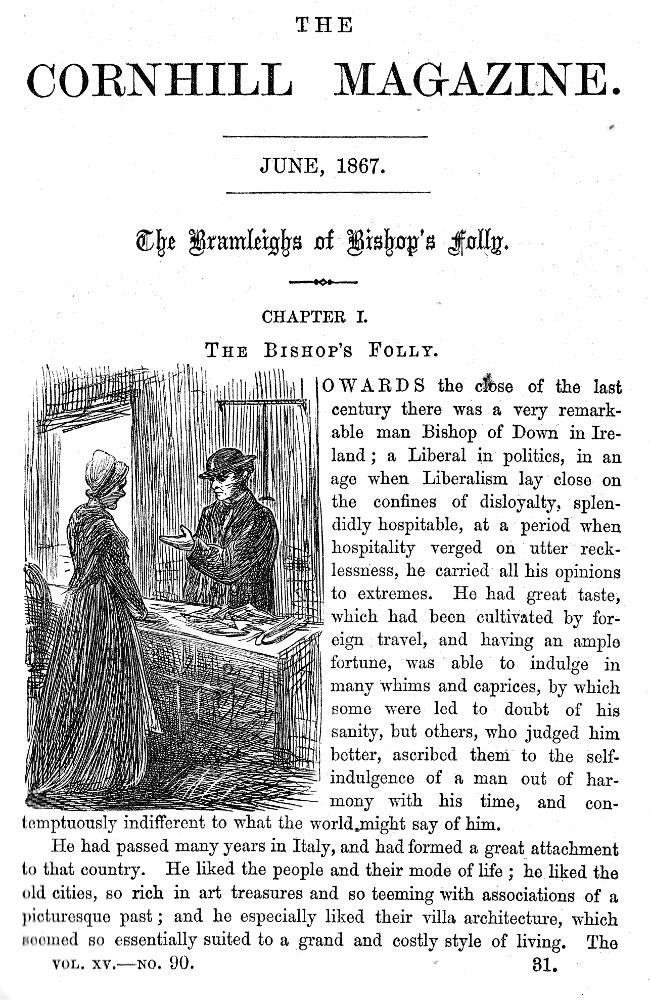

Initial-letter Vignette "T" (The Bishop of Down chats with Jack Bramleigh at the window) (Vol. XV, page 641) vertically-mounted, 7.5 cm high by 4.9 cm wide, signed "MEE." in the lower-left corner of the main illustration. Mary Ellen Edwards, initial thumbnail vignette illustration for Charles Lever's The Bramleighs of Bishop's Folly in the Cornhill Magazine (Juner 1867), Chapters I-V ("The Bishop's Folly" through Confidential Talk.") in Vol. 15: pages 640 through 664 (24 pages in instalment). The wood-engraver responsible for this illustration was Joseph Swain (1820-1909), noted for his engravings of Sir John Tenniel's cartoons in Punch. [Click on the image to enlarge it; mouse over links.]
This initial-letter vignette complements the opening passage in Ch. 1:
Towards the close of the last century there was a very remarkable man, Bishop of Down, in Ireland: a Liberal in politics, in an age when Liberalism lay close on the confines of disloyalty; splendidly hospitable, at a period when hospitality verged on utter recklessness; he carried all his opinions to extremes. He had great taste, which had been cultivated by foreign travel, and having an ample fortune, was able to indulge in many whims and caprices, by which some were led to doubt of his sanity; but others, who judged him better, ascribed them to the self-indulgence of a man out of harmony with his time, and comtemptuously indifferent to what the world might say of him. [Vol. XV, p. 641].
Comment: Introducing the Necessary Background
Thus, the opening vignette leads the reader immediately into Lever's antecedent action for the opening scene in Chapter I of the novella, merging the illustration and the text through the initial letter "T" for "Towards," which introduces the flashback paragraphs involving the Bishop of Down and his "folly," a magnificent edifice in one of Ireland's remotest relions. However, the picture does not concern the Bishop, but "Captain" Crauford, who is talking to the postmistress of Portshandon, Mrs. Bayley, as she points "to a pile of letters and newspapers all addressed to 'Castello'" (643). Thus, Edwards does not concern herself with the flashback about the origins of Bishop's Folly, but rather with its sudden renovation and occupancy by a wealthy London banking family. The local authority about the affairs of the outside world, the half-pay lieutenant whom the villagers dignify with the title "Captain," expresses mystification as to why wealthy Londoners would give up Hyde Park and the Queen's palace for so removed a spot. The actual passage illustrated is this:
“And do they think they'll make it better by calling it Castello?” said he, as with a contemptuous gesture he threw from him one of the newspapers with this address. “If they want to think they're in Italy they ought to come down here in November with the Channel fogs sweeping up through the mountains, and the wind beating the rain against the windows. I hope they'll think they're in Naples. Why can't they call the place by the name we all know it by? It was Bishop's Folly when I was a boy, and it will be Bishop's Folly after I'm dead.”
“I suppose people can call their house whatever they like? Nobody objects to your calling your place Craufurd's Lea.”
“I'd like to see them object to it,” cried he, fiercely. “It's Craufurd's Lea in Digge's Survey of Down, 1714. It's Craufurd's Lea in the Anthologia Hibernica, and it's down, too, in Joyce's Irish Fisheries; and we were Craufurds of Craufurd's Lea before one stone of that big barrack up there was laid, and maybe we'll be so after it's a ruin again.” [643]
In this way, the illustration points readers towards local attitudes to the "Folly," and immediately establishes expectations about the family that are coming from abroad to occupy the estate. Edwards thereby complements the background of the Castello with the fashionable young people playing croquet in the opening scene, the instalment's main illustration on the facing page (640), On the Croquet Lawn. Clearly, Edwards felt that it was more important to depict the locals and the family of newcomers than it was the Castello itself.
Scanned images and text by Philip V. Allingham. [You may use these images without prior permission for any scholarly or educational purpose as long as you (1) credit the person who scanned the image and (2) link your document to this URL in a web document or cite the Victorian Web in a print one.]
Bibliography
Lever, Charles. The Bramleighs of Bishop’s Folly. The Cornhill Magazine 15 (June, 1867): pp. 640-664, and (July-December 1867): 1-666. Rpt. London: Chapman & Hall, 1872. Illustrated by M. E. Edwards; engraved by Joseph Swain.
Stevenson, Lionel. "Chapter XVI: Exile on the Adriatic, 1867-1872." Dr. Quicksilver: The Life of Charles Lever. London: Chapman and Hall, 1939. Pp. 277-296.
Created 24 August 2023